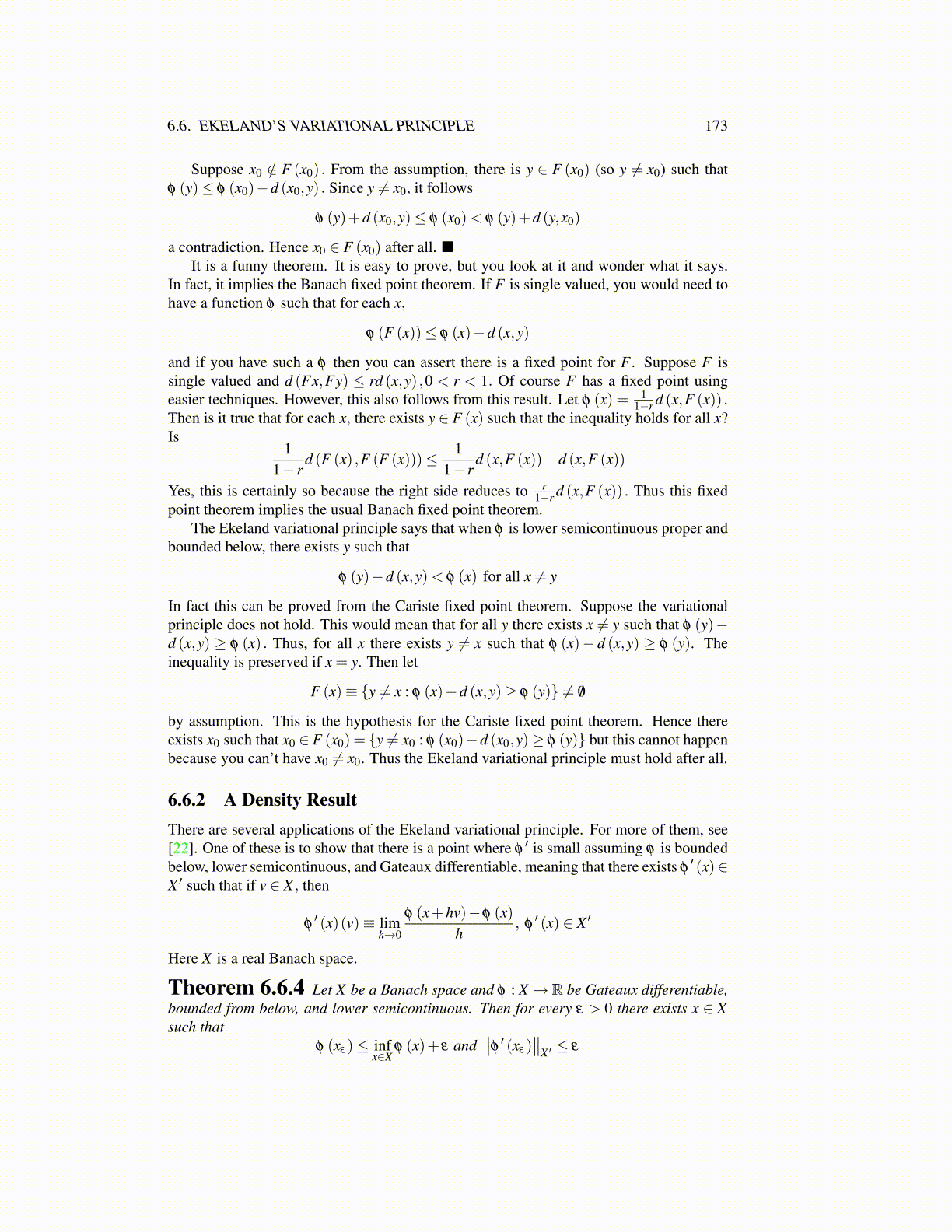
6.6. EKELAND’S VARIATIONAL PRINCIPLE 173
Suppose x0 /∈ F (x0) . From the assumption, there is y ∈ F (x0) (so y ̸= x0) such thatφ (y)≤ φ (x0)−d (x0,y) . Since y ̸= x0, it follows
φ (y)+d (x0,y)≤ φ (x0)< φ (y)+d (y,x0)
a contradiction. Hence x0 ∈ F (x0) after all. ■It is a funny theorem. It is easy to prove, but you look at it and wonder what it says.
In fact, it implies the Banach fixed point theorem. If F is single valued, you would need tohave a function φ such that for each x,
φ (F (x))≤ φ (x)−d (x,y)
and if you have such a φ then you can assert there is a fixed point for F . Suppose F issingle valued and d (Fx,Fy) ≤ rd (x,y) ,0 < r < 1. Of course F has a fixed point usingeasier techniques. However, this also follows from this result. Let φ (x) = 1
1−r d (x,F (x)) .Then is it true that for each x, there exists y ∈ F (x) such that the inequality holds for all x?Is
11− r
d (F (x) ,F (F (x)))≤ 11− r
d (x,F (x))−d (x,F (x))
Yes, this is certainly so because the right side reduces to r1−r d (x,F (x)) . Thus this fixed
point theorem implies the usual Banach fixed point theorem.The Ekeland variational principle says that when φ is lower semicontinuous proper and
bounded below, there exists y such that
φ (y)−d (x,y)< φ (x) for all x ̸= y
In fact this can be proved from the Cariste fixed point theorem. Suppose the variationalprinciple does not hold. This would mean that for all y there exists x ̸= y such that φ (y)−d (x,y) ≥ φ (x) . Thus, for all x there exists y ̸= x such that φ (x)− d (x,y) ≥ φ (y). Theinequality is preserved if x = y. Then let
F (x)≡ {y ̸= x : φ (x)−d (x,y)≥ φ (y)} ̸= /0
by assumption. This is the hypothesis for the Cariste fixed point theorem. Hence thereexists x0 such that x0 ∈ F (x0) = {y ̸= x0 : φ (x0)−d (x0,y)≥ φ (y)} but this cannot happenbecause you can’t have x0 ̸= x0. Thus the Ekeland variational principle must hold after all.
6.6.2 A Density ResultThere are several applications of the Ekeland variational principle. For more of them, see[22]. One of these is to show that there is a point where φ
′ is small assuming φ is boundedbelow, lower semicontinuous, and Gateaux differentiable, meaning that there exists φ
′ (x)∈X ′ such that if v ∈ X , then
φ′ (x)(v)≡ lim
h→0
φ (x+hv)−φ (x)h
, φ′ (x) ∈ X ′
Here X is a real Banach space.
Theorem 6.6.4 Let X be a Banach space and φ : X → R be Gateaux differentiable,bounded from below, and lower semicontinuous. Then for every ε > 0 there exists x ∈ Xsuch that
φ (xε)≤ infx∈X
φ (x)+ ε and∥∥φ′ (xε)
∥∥X ′ ≤ ε